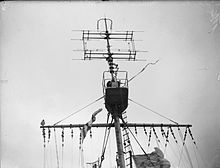130:
208:. The Type 281 ranging system allowed the user to select either a 2,000 yards (1,830 m) to 14,000 yards (12,800 m) or a 2,000 yards (1,830 m) to 25,000 yards (22,860 m) range display with range accuracies of 50 yards (50 m) or 75 yards (70 m) RMS, respectively. Aerial target ranges were passed directly to the
216:
140 mi). At lower altitudes, ranges declined to 90 nautical miles (170 km; 100 mi) at 10,000 feet (3,050 m) and 65 nautical miles (120 km; 75 mi) at 5,000 feet (1,520 m). The Type 281BQ was a Type 281BP fitted with power rotation, at 2 or 4 rpm, and equipped with a
215:
Type 281B consolidated the transmission and receiving antennas while the Type 281BP radar had the short-pulse feature removed. It was fitted with improved receivers that increased the maximum detection range for an aircraft at 20,000 feet (6,100 m) to 120 nautical miles (220 km;
189:
of 3.5 m (3.8 yd). It required separate transmitting and receiving antennas that were rotated by hand. For long-range warning the radar used a 15 microsecond pulse at a power level of 350 kW that gave a detection range up to 110
194:(200 km; 130 mi) for aircraft. For tracking surface targets it used a 2–3 microsecond pulse at 1 MW that gave a range up to 12 nautical miles (22 km; 14 mi). A second set was installed in January 1941 aboard the
204:
and production began of another 57 sets with the first deliveries occurring the following month. This set also had a secondary aerial and surface gunnery capability and used a
423:
205:
408:
392:
373:
354:
335:
316:
297:
129:
433:
345:
Mitchell, Alastair (1980). "The
Development of Radar in the Royal Navy (1935–45), Part I". In Roberts, John (ed.).
72:
438:
198:
217:
428:
221:
149:
57:
134:
388:
369:
350:
331:
312:
293:
328:
The
Application of Radar and other Electronic Systems in the Royal Navy in World War 2
417:
191:
171:
168:
157:
104:
385:
Radar
Origins Worldwide: History of Its Evolution in 13 Nations Through World War II
153:
326:
Pout, H.W. (1995). "Weapon
Direction in the Royal Navy". In Kingsley, F.A. (ed.).
195:
186:
161:
182:
178:
82:
290:
A Radar
History of World War II: Technological and Military Imperatives
128:
209:
16:
British naval early-warning radar developed during World War II
292:. Bristol and Philadelphia: Institute of Physics Publishing.
220:. After the end of the war, the Type 281 was replaced by the
119:
111:
99:
91:
81:
71:
63:
53:
42:
34:
26:
8:
366:Technical History of the Beginnings of Radar
164:'s main early-warning radar during the war.
21:
20:
167:The prototype system was mounted on the
409:The RN Radar and Communications Museum
232:
7:
177:in October 1940. This radar used a
14:
349:. London: Conway Maritime Press.
311:. London: Conway Maritime Press.
424:World War II British electronics
368:. London: IEE/Peter Peregrinus.
383:Watson, Raymond C. Jr. (2009).
212:table (fire control computer).
43:
1:
455:
115:30,000 feet (9,100 m)
107:(213 km; 132 mi)
307:Friedman, Norman (1981).
364:Swords, Sean S. (1986).
218:plan position indicator
206:Precision Ranging Panel
141:
133:281 B Aerial on board
27:Country of origin
330:. London: Macmillan.
288:Brown, Louis (1999).
266:Pout, pp. 13–16.
132:
148:was a British naval
434:World War II radars
150:early-warning radar
58:Early-warning radar
23:
248:Mitchell, pp. 8–10
181:of 90 MHz, a
156:. It replaced the
142:
394:978-1-4269-2111-7
152:developed during
127:
126:
446:
439:Royal Navy Radar
398:
379:
360:
341:
322:
303:
276:
275:Friedman, p. 194
273:
267:
264:
258:
255:
249:
246:
240:
237:
87:35° (horizontal)
45:
24:
454:
453:
449:
448:
447:
445:
444:
443:
414:
413:
405:
395:
382:
376:
363:
357:
344:
338:
325:
319:
306:
300:
287:
284:
279:
274:
270:
265:
261:
256:
252:
247:
243:
238:
234:
230:
201:Prince of Wales
95:2–3 μs or 15 μs
17:
12:
11:
5:
452:
450:
442:
441:
436:
431:
426:
416:
415:
412:
411:
404:
403:External links
401:
400:
399:
393:
380:
374:
361:
355:
342:
336:
323:
317:
304:
298:
283:
280:
278:
277:
268:
259:
250:
241:
231:
229:
226:
222:Type 960 radar
192:nautical miles
185:of 35°, and a
146:Type 281 radar
140:at Scapa Flow.
125:
124:
121:
117:
116:
113:
109:
108:
101:
97:
96:
93:
89:
88:
85:
79:
78:
75:
69:
68:
65:
61:
60:
55:
51:
50:
47:
40:
39:
36:
32:
31:
30:United Kingdom
28:
15:
13:
10:
9:
6:
4:
3:
2:
451:
440:
437:
435:
432:
430:
427:
425:
422:
421:
419:
410:
407:
406:
402:
396:
390:
386:
381:
377:
375:0-86341-043-X
371:
367:
362:
358:
356:0-85177-205-6
352:
348:
343:
339:
337:0-333-62748-2
333:
329:
324:
320:
318:0-85177-238-2
314:
310:
305:
301:
299:0-7503-0659-9
295:
291:
286:
285:
281:
272:
269:
263:
260:
257:Swords, p. 88
254:
251:
245:
242:
239:Swords, p. 88
236:
233:
227:
225:
223:
219:
213:
211:
207:
203:
202:
197:
193:
188:
184:
180:
176:
175:
170:
169:light cruiser
165:
163:
159:
155:
151:
147:
139:
138:
131:
122:
118:
114:
110:
106:
102:
98:
94:
90:
86:
84:
80:
77:50 per second
76:
74:
70:
66:
62:
59:
56:
52:
48:
41:
37:
33:
29:
25:
19:
429:Naval radars
387:. Trafford.
384:
365:
346:
327:
308:
289:
282:Bibliography
271:
262:
253:
244:
235:
214:
200:
173:
166:
154:World War II
145:
143:
136:
18:
309:Naval Radar
123:350 kW–1 MW
418:Categories
347:Warship IV
196:battleship
187:wavelength
162:Royal Navy
92:Pulsewidth
35:Introduced
199:HMS
183:beamwidth
179:frequency
172:HMS
137:Swiftsure
135:HMS
103:115
83:Beamwidth
67:86–94 MHz
64:Frequency
112:Altitude
22:Type 281
160:as the
158:Type 79
391:
372:
353:
334:
315:
296:
228:Notes
120:Power
100:Range
46:built
389:ISBN
370:ISBN
351:ISBN
332:ISBN
313:ISBN
294:ISBN
210:HACS
174:Dido
144:The
54:Type
38:1940
105:nmi
73:PRF
44:No.
420::
224:.
49:59
397:.
378:.
359:.
340:.
321:.
302:.
Text is available under the Creative Commons Attribution-ShareAlike License. Additional terms may apply.
